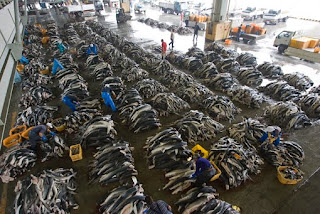
The oceans are a shadow of what they once were, and it is unlikely we can keep what little we have left unless we act right now. Here's a combination of ideas, which if used together in one concerted effort, may stop the rot.
1. More marine reserves. Eleven-percent of the UK landmass is protected but less than one percent of our entire surrounding seas. Our first national park was created in 1951 but it was only 2003 when the tiny Lundy Island Marine Reserve received a no-take zone status. The situation is similar or worse in most of the world's seas. It is time to stop treating our oceans as second-class ecosystems.
2. Subsidies for the fishing industry must stop. The EU has been subsidising the denudation of our oceans to the tune of €4.4 billion over a 12 year period. Spain, possibly the most rapacious fishing country on earth, got 48% of the subsidies dispensed. It would be hard to imagine a similar situation on land, where wild animals are hunted to near extinction with the aid of European taxpayers money. It is a legalised, government funded destruction on an unimaginable scale, and it must stop.
3. The sportfishing industry should change its practices and image. As is the case with land animals there is now no excuse for killing endangered large marine fish for sport and trophies. Despite this a significant minority of people in the sport fishing community are still killing these fish as proof of their endeavours in a similar vain to the great white hunters of the 1950's. This is the acceptable and media friendly face of marine animal slaughter, and it should no longer be tolerated.
4. Stop expanding the commercial exploitation of marine animals. There has to be a point where we draw a line under marine over-exploitation. Ideally we should have done this some time ago, but since we haven't we now have the perfect opportunity. Krill, the food of numerous marine species, may over the next 50-100 years be sacrificed for an oil that has intangible human health benefits and that is available from other less important living sources. Omega 3 oil can be obtained from linseed and flaxseed and need not be derived from a species so vital to the marine ecosystem. The exploitation of krill is where the line needs to be drawn in the sand.
5. Intergovernmental Panel on Marine Exploitation. Two-thirds of the Earth is fast becoming a biological desert and if the destruction of our marine ecosystems is to be halted, and ultimately reversed, bold, systematic, and effective measures are needed now. An intergovernmental panel on marine exploitation, if backed up by proper exhaustive fisheries science, may galvanise world opinion in a similar way that the IPCC has done for climate change.


.jpg)
.jpg)
